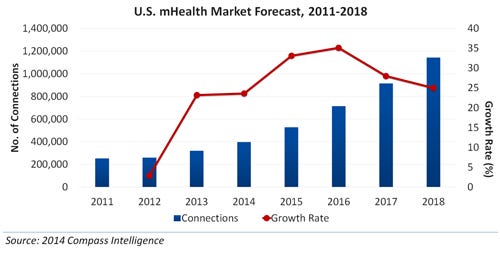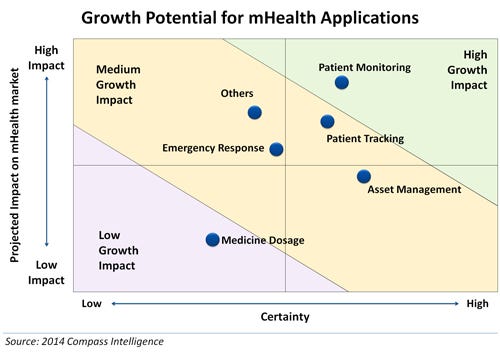A new report on the opportunities and increased investment in all parts of the mhealth ecosystem describes five segments that have the most potential for growth.
April 23, 2014

.jpg?width=700&auto=webp&quality=80&disable=upscale)
A new report projects that the U.S. mhealth market will grow to 1.14 million connections in 2018, up from 321,324 in 2013.
Compass Intelligence, which published the report - mHealth Market Analysis: Opportunities and Evolving Ecosystem - defines connections as separate devices that each, individually connect over a wireless network. If multiple devices in a patient’s home or in a hospital connect through a central hub, that counts as one connection.

The projection records a more than a three-fold increase in the number of connections just five years. So which areas of mhealth will likely have the most growth potential in the immediate future? Compass Intelligence describes the following five in the order of its ability to be monetized.
Patient monitoring
Patient monitoring has been the fastest area of growth fueled by continuous advances in wireless connectivity as well as embedded , smart sensors. This has boosted the adoption of glucose and diabetic monitoring, cardiac monitoring as well as blood pressure monitoring solutions.
Presumably one of the reasons for fast growth is because the segment poses relatively lower barriers to entry is less complex in terms of connectivity, usage, and overall business model architecture, the report states. Doctors and hospitals have been very optimistic in promoting patient monitoring solutions, with one prominent cardiologist talking about prescribing apps to patients instead of drugs.
A growing aging and tech-savvy population will drive future growth in this market, making remote patient management the fastest growing segments within mHealth market globally.
Patient tracking
This ranks in second place of the overall mhealth market, the report says. The need to track patients with chronic diseases such as Alzheimer’s and dementia is huge and solutions offering such capability are on the rise. For instance, Project Lifesaver's Protect and Locate Tracker system is a digital sports watch that is able to use cellular and GPS technology to make sure that a caregiver knows where a patient with dementia and Alzheimer’s may be.
Aside from such applications, future applications of patient tracking might involve small sensors embedded in clothes, the report states.
Interested in sensors and how they might improve device efficiency? Hear the founder of Misfit Wearables address this topic at the MD&M East Exposition and Conference, June 9, New York City. |
Emergency response
This forms the third segment in terms of growth potential. The report states that machine-to-machine technology and sensors can be used in various ways to implement remote monitoring and communication with emergency response care teams and hospitals.
Medicine dosage
A big area of growth is in the realm of drug dosage given that machine-to-machine penetration of this segment is relatively negligible. Nonetheless, there are new products that can offer drug dosage to patients at the right time with the right dosage using sensor technology. For instance, Proteus Digital Health is developing what it calls digital medicines - a pill with a sensor - that can tell doctors whether patients are taking their medications as prescribed and how the drugs are interacting with the body.
Asset Management
This segment doesn’t sound as exciting as patient monitoring and yet has strong money making capability. The report states that similar to the food industry, machine-to-machine applications can help monitor storage of medicines, determine if there any changes in storage conditions as well as track assets such as emergency vehicles, medical equipment and other assets.
Here is a chart on the report that plots the growth potential of these five mhealth segments.

[Photo Credit: iStockphotoc,com user -hakusan-]
-- By Arundhati Parmar, Senior Editor, MD+DI
[email protected]
You May Also Like


